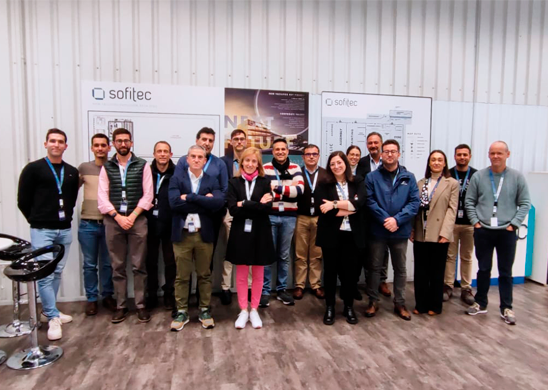
How AI-based sensing algorithms are transforming critical industries: A conversation with Iñaki Aguirre
Artificial intelligence and autonomous sensing have burst into our lives and industry with unstoppable force. These advanced technologies promise to revolutionise the way we assess and ensure quality in crucial sectors such as aerospace, rail and wind energy. To shed light on the present and future of these innovations, we spoke to Iñaki Aguirre, our Project Manager and NDT Specialist.
In this interview, we will explore how AI-based sensing algorithms are transforming critical industries, the technical and ethical challenges they face and the short and long-term evolution prospects.
/ What is the role of AI-based detection algorithms in the development of intelligent systems?
In this interview, we will explore how AI-based sensing algorithms are transforming critical industries, the technical and ethical challenges they face and the short and long-term evolution prospects.
/ How do these developments compare with the current situation in automated inspection?
Currently, despite significant advances in automated inspection systems, the evaluation phase often requires the intervention of a human inspector to determine whether a component is good or bad. This is due to the complexity of decision making and the lack of objective, fast and reliable tools to deal with massive volumes of data.
/ In what specific areas could these new autonomous sensing algorithms benefit the most?
These new algorithms are especially valuable in areas where there is a large volume of data and quality assurance is essential, such as component manufacturing, in-line product inspection and preventive maintenance, among others. The ability to make fast, objective decisions in highly complex environments is a significant advance in the automation of inspection processes..
/ What are the main technical and ethical challenges in the development of autonomous sensing algorithms?
The challenges in the development of autonomous sensing algorithms are significant and need to be carefully addressed.
The main technical challenge lies in achieving accuracy levels close to or equal to 100%. Currently, algorithms have come a long way and their accuracy is above 90%, but they still fall short of the accuracies required by the industry. This challenge involves constantly improving the quality of algorithms and minimising errors.
This is where a major ethical dilemma arises: how do we balance the need for absolute accuracy with the possibility of errors? One solution is to encourage collaboration between the inspection operator and the algorithm. Steps are being taken to have the initial algorithms evaluate most results with high accuracy, allowing the operator to focus on and monitor cases where the algorithm’s predictions are not reliable enough for high quality standards. In this sense, the idea is to implement a new paradigm in which the operator can concentrate on evaluating the most critical results, while AI-based tools help him or her to make decisions. This not only reduces the workload involved in reviewing a large number of results, but also reduces the stress associated with making crucial decisions in highly complex situations.
/ What benefits are expected from this collaborative approach?
This collaborative approach is expected to improve the efficiency and quality of inspection by allowing algorithms to do most of the heavy lifting and allowing operators to concentrate on making decisions in highly complex situations. In addition, AI tools can help the operator to make decisions, thereby reducing the possibility of human error and ensuring higher quality standards in the evaluation of results.
Ultimately, the development of AI-based detection algorithms involves a delicate balance between technical accuracy and ethical decision-making. Collaboration between humans and AI systems seems to be the way forward to address these challenges and maximise the potential of automation in inspection and outcome assessment.
/ How important will the application of AI-based algorithms be in critical industries such as aerospace, rail and wind power?
The application of AI-based detection algorithms in these industries is of vital importance because of the need to ensure the quality of components, as failure could have serious consequences, including the loss of human lives.
/ What is the approach to implementing AI algorithms in these industries?
The implementation of AI algorithms varies depending on the type of algorithm. For example, for Deep Learning-based algorithms, it is essential to have a training phase that includes both defective and good parts. This learning process is the basis of the algorithm and is used to compare results during the evaluation phase.
After completing the initial phase, we move on to implementation, where it is essential to adjust and retrain the model to suit real manufacturing conditions, taking into account possible imperfections that were not detected during the initial training phase.
/ How is the model adjusted and retrained during the implementation phase?
At this point in the process, the contribution of the operator or inspector becomes a key element. Their experience and knowledge play a key role in adapting the model to the specific needs of the actual inspection of the component. This collaboration between artificial intelligence and human expertise is known as “Human in the loop”, and results in a synergy that enhances the effectiveness of the system. The operator or inspector not only guides the optimisation of the model, but also identifies possible discrepancies and defects that may have gone unnoticed during the initial training phase.
This dynamic interaction between the artificial intelligence and the operator adds an additional level of quality and accuracy to the inspection process, ensuring that the model perfectly matches the actual manufacturing conditions and needs.
/ What is the ultimate goal of implementing these algorithms in these industries?
The ultimate goal is to achieve zero-defect manufacturing, known as Zero Defects Manufacturing (ZDM), where autonomous sensing algorithms work collaboratively and efficiently alongside human personnel to ensure the quality and safety of components. This is essential to maintain high safety and quality standards in these critical industries.
/ To conclude the interview, how do you foresee autonomous sensing and artificial intelligence evolving in the coming years? What are the immediate trends we can expect in this field?
The evolution of autonomous sensing and artificial intelligence in the coming years is an exciting and dynamic topic.
In the short term, the main goal is to achieve predictive models that are 100% reliable and to implement them in industry. This implies further investment in research and development, as well as continuous improvement of algorithms and technologies.
/ And in the long term, what can we anticipate in terms of evolution?
In the long term, the strategy will focus on defining the optimal collaboration between AI algorithms and human operators. It’s about recognizing and capitalizing on the strengths of each. Algorithms can process large amounts of data efficiently, while humans bring intuition, experience and ethical judgment. Efficient collaboration between the two will be key to tackling complex problems. Similarly, we need to ensure the safety and ethics of algorithmic decision making, as well as the continuous adaptation of models as conditions and quality standards evolve. In addition, education and training of professionals in the use of these technologies will be essential to take full advantage of their potential and ensure quality in various industries.
endity



